Financial Reporting: Conceptual Framework, Stakeholders, and Analysis
VerifiedAdded on 2021/02/20
|16
|4689
|26
Report
AI Summary
This report provides a comprehensive overview of financial reporting, beginning with its fundamental concepts and purpose. It explores the roles of various stakeholders, including internal (employees, managers) and external (customers, suppliers, shareholders) parties, and how they benefit from financial information. The report then delves into the conceptual and regulatory frameworks that guide financial reporting, emphasizing the importance of qualitative characteristics such as relevance, reliability, understandability, and comparability. A key component of the report is an analysis of financial statements, using Golwin Plc as a case study, including a profit and loss account, balance sheet, and statements of changes in equity. Furthermore, the report examines ratio analysis to assess financial performance and liquidity, and it concludes by comparing and contrasting the International Financial Reporting Standards (IFRS) and International Accounting Standards (IAS), discussing their benefits and the varying degrees of compliance across the globe. The report aims to provide a clear understanding of financial reporting and its practical applications.
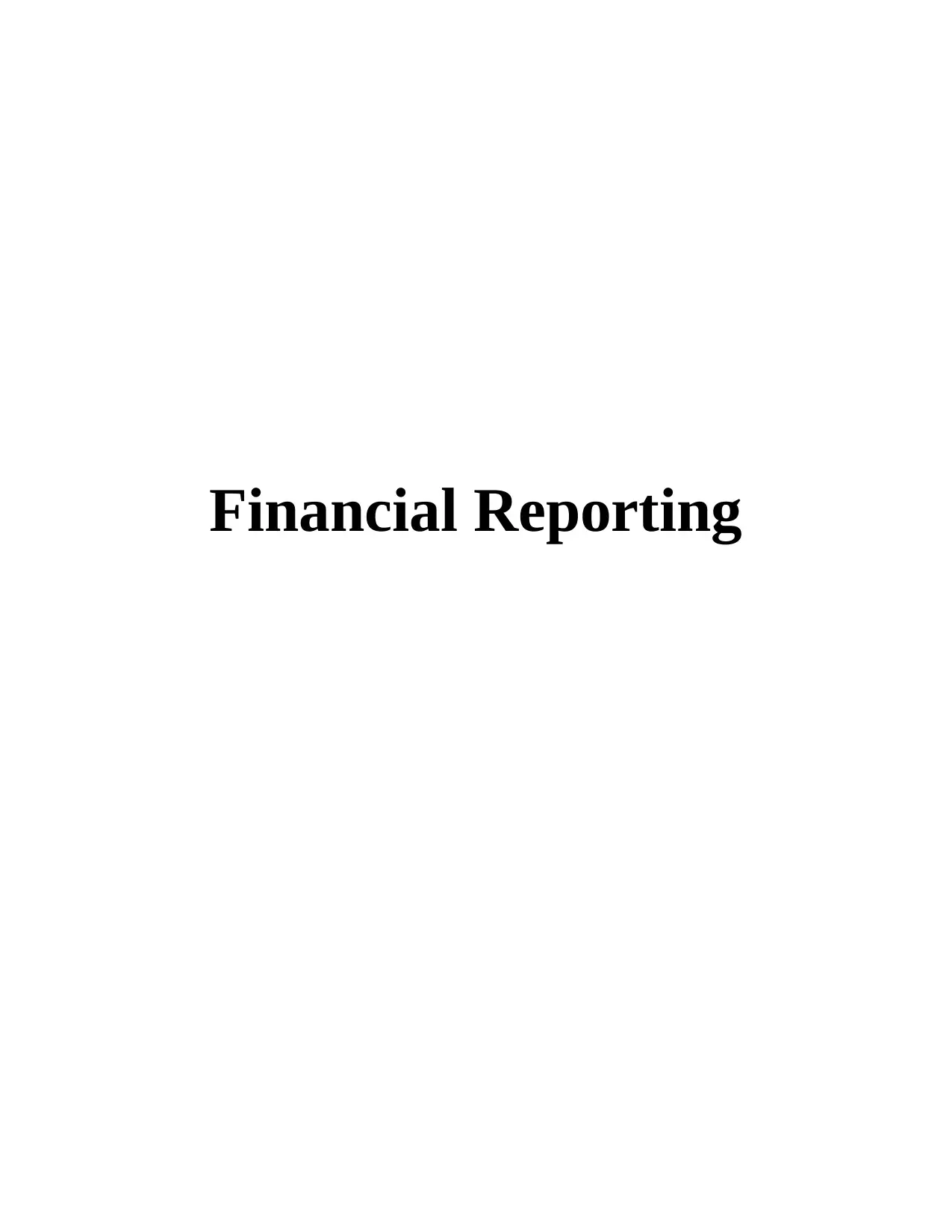
Financial Reporting
Paraphrase This Document
Need a fresh take? Get an instant paraphrase of this document with our AI Paraphraser

Table of Contents
INTRODUCTION...........................................................................................................................1
MAIN BODY...................................................................................................................................1
LO1..................................................................................................................................................1
P1 Financial reporting concept and purpose................................................................................1
P2 Conceptual and regulatory framework and the qualitative characteristics of financial
information...................................................................................................................................2
P3 Key Stakeholders or users of Tesco and how they take benefits from financial information
......................................................................................................................................................3
P4 Value of Financial Reporting:................................................................................................4
LO2..................................................................................................................................................5
P5 financial statements of Golwin plc. Company........................................................................5
P6 Ratio Analysis.........................................................................................................................7
LO3..................................................................................................................................................9
P7 Difference between IAS and IFRS.........................................................................................9
P8 Benefits of IFRS...................................................................................................................11
LO 4...............................................................................................................................................12
P9 Varying degree of compliance of IFRS across the world.....................................................12
CONCLUSION..............................................................................................................................12
REFERENCES..............................................................................................................................13
INTRODUCTION...........................................................................................................................1
MAIN BODY...................................................................................................................................1
LO1..................................................................................................................................................1
P1 Financial reporting concept and purpose................................................................................1
P2 Conceptual and regulatory framework and the qualitative characteristics of financial
information...................................................................................................................................2
P3 Key Stakeholders or users of Tesco and how they take benefits from financial information
......................................................................................................................................................3
P4 Value of Financial Reporting:................................................................................................4
LO2..................................................................................................................................................5
P5 financial statements of Golwin plc. Company........................................................................5
P6 Ratio Analysis.........................................................................................................................7
LO3..................................................................................................................................................9
P7 Difference between IAS and IFRS.........................................................................................9
P8 Benefits of IFRS...................................................................................................................11
LO 4...............................................................................................................................................12
P9 Varying degree of compliance of IFRS across the world.....................................................12
CONCLUSION..............................................................................................................................12
REFERENCES..............................................................................................................................13
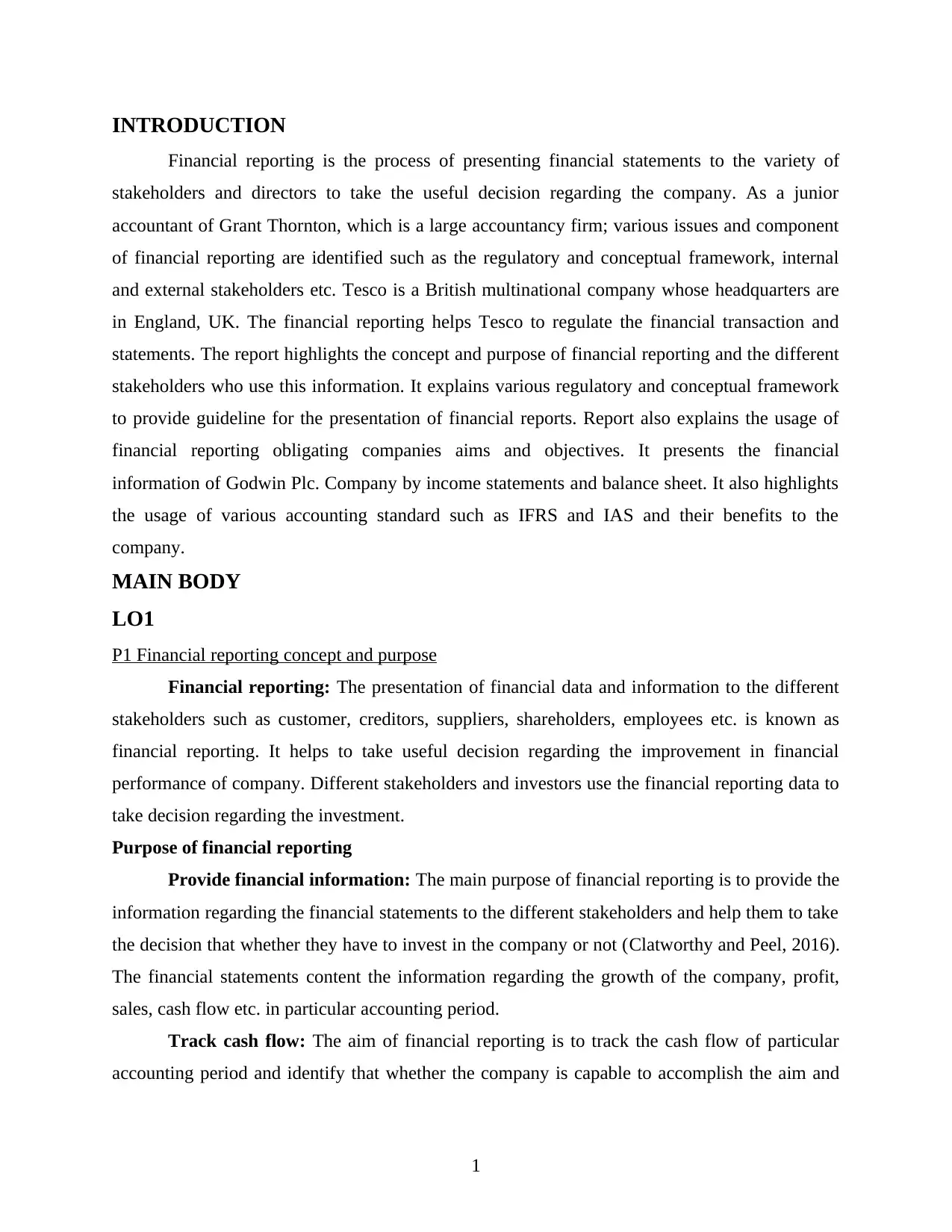
INTRODUCTION
Financial reporting is the process of presenting financial statements to the variety of
stakeholders and directors to take the useful decision regarding the company. As a junior
accountant of Grant Thornton, which is a large accountancy firm; various issues and component
of financial reporting are identified such as the regulatory and conceptual framework, internal
and external stakeholders etc. Tesco is a British multinational company whose headquarters are
in England, UK. The financial reporting helps Tesco to regulate the financial transaction and
statements. The report highlights the concept and purpose of financial reporting and the different
stakeholders who use this information. It explains various regulatory and conceptual framework
to provide guideline for the presentation of financial reports. Report also explains the usage of
financial reporting obligating companies aims and objectives. It presents the financial
information of Godwin Plc. Company by income statements and balance sheet. It also highlights
the usage of various accounting standard such as IFRS and IAS and their benefits to the
company.
MAIN BODY
LO1
P1 Financial reporting concept and purpose
Financial reporting: The presentation of financial data and information to the different
stakeholders such as customer, creditors, suppliers, shareholders, employees etc. is known as
financial reporting. It helps to take useful decision regarding the improvement in financial
performance of company. Different stakeholders and investors use the financial reporting data to
take decision regarding the investment.
Purpose of financial reporting
Provide financial information: The main purpose of financial reporting is to provide the
information regarding the financial statements to the different stakeholders and help them to take
the decision that whether they have to invest in the company or not (Clatworthy and Peel, 2016).
The financial statements content the information regarding the growth of the company, profit,
sales, cash flow etc. in particular accounting period.
Track cash flow: The aim of financial reporting is to track the cash flow of particular
accounting period and identify that whether the company is capable to accomplish the aim and
1
Financial reporting is the process of presenting financial statements to the variety of
stakeholders and directors to take the useful decision regarding the company. As a junior
accountant of Grant Thornton, which is a large accountancy firm; various issues and component
of financial reporting are identified such as the regulatory and conceptual framework, internal
and external stakeholders etc. Tesco is a British multinational company whose headquarters are
in England, UK. The financial reporting helps Tesco to regulate the financial transaction and
statements. The report highlights the concept and purpose of financial reporting and the different
stakeholders who use this information. It explains various regulatory and conceptual framework
to provide guideline for the presentation of financial reports. Report also explains the usage of
financial reporting obligating companies aims and objectives. It presents the financial
information of Godwin Plc. Company by income statements and balance sheet. It also highlights
the usage of various accounting standard such as IFRS and IAS and their benefits to the
company.
MAIN BODY
LO1
P1 Financial reporting concept and purpose
Financial reporting: The presentation of financial data and information to the different
stakeholders such as customer, creditors, suppliers, shareholders, employees etc. is known as
financial reporting. It helps to take useful decision regarding the improvement in financial
performance of company. Different stakeholders and investors use the financial reporting data to
take decision regarding the investment.
Purpose of financial reporting
Provide financial information: The main purpose of financial reporting is to provide the
information regarding the financial statements to the different stakeholders and help them to take
the decision that whether they have to invest in the company or not (Clatworthy and Peel, 2016).
The financial statements content the information regarding the growth of the company, profit,
sales, cash flow etc. in particular accounting period.
Track cash flow: The aim of financial reporting is to track the cash flow of particular
accounting period and identify that whether the company is capable to accomplish the aim and
1
⊘ This is a preview!⊘
Do you want full access?
Subscribe today to unlock all pages.

Trusted by 1+ million students worldwide
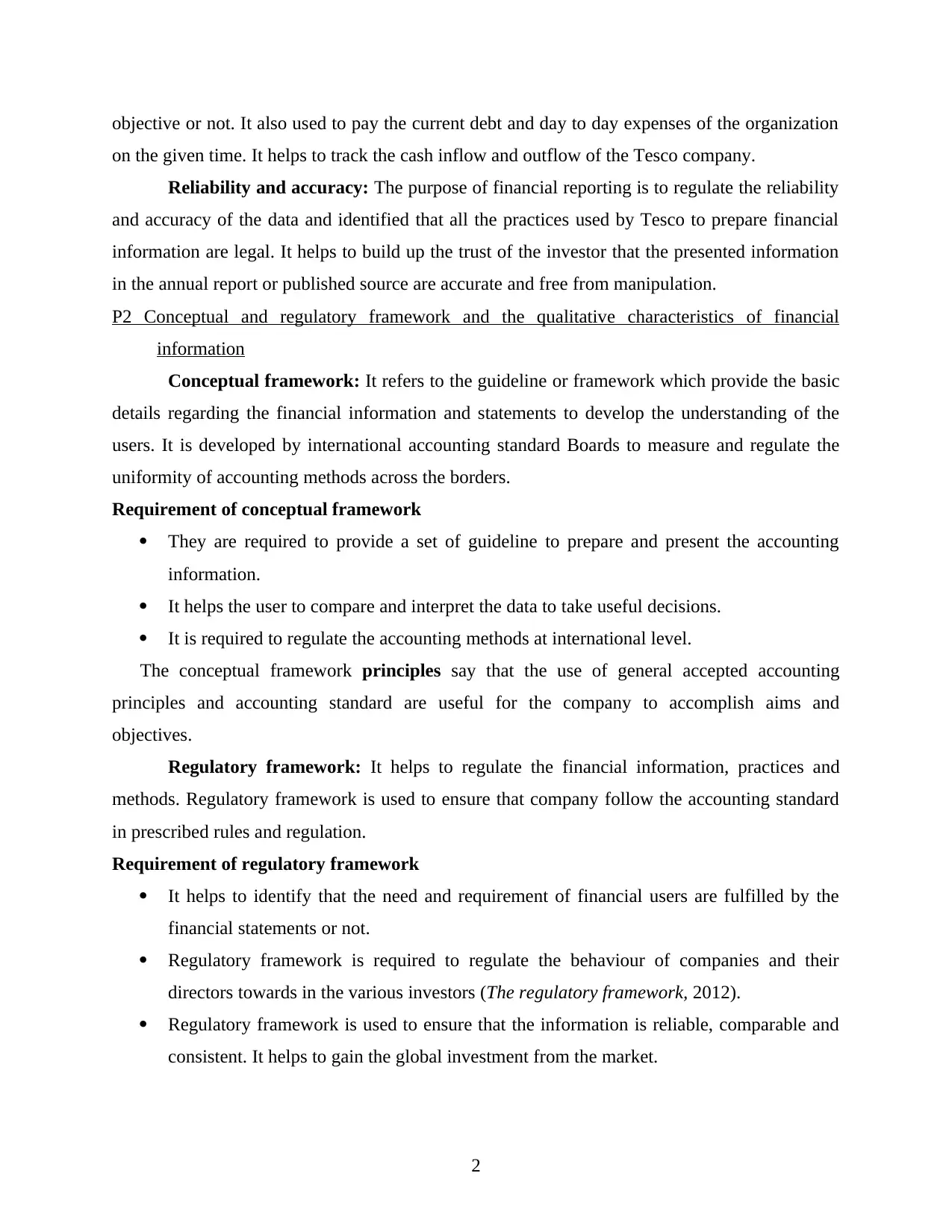
objective or not. It also used to pay the current debt and day to day expenses of the organization
on the given time. It helps to track the cash inflow and outflow of the Tesco company.
Reliability and accuracy: The purpose of financial reporting is to regulate the reliability
and accuracy of the data and identified that all the practices used by Tesco to prepare financial
information are legal. It helps to build up the trust of the investor that the presented information
in the annual report or published source are accurate and free from manipulation.
P2 Conceptual and regulatory framework and the qualitative characteristics of financial
information
Conceptual framework: It refers to the guideline or framework which provide the basic
details regarding the financial information and statements to develop the understanding of the
users. It is developed by international accounting standard Boards to measure and regulate the
uniformity of accounting methods across the borders.
Requirement of conceptual framework
They are required to provide a set of guideline to prepare and present the accounting
information.
It helps the user to compare and interpret the data to take useful decisions.
It is required to regulate the accounting methods at international level.
The conceptual framework principles say that the use of general accepted accounting
principles and accounting standard are useful for the company to accomplish aims and
objectives.
Regulatory framework: It helps to regulate the financial information, practices and
methods. Regulatory framework is used to ensure that company follow the accounting standard
in prescribed rules and regulation.
Requirement of regulatory framework
It helps to identify that the need and requirement of financial users are fulfilled by the
financial statements or not.
Regulatory framework is required to regulate the behaviour of companies and their
directors towards in the various investors (The regulatory framework, 2012).
Regulatory framework is used to ensure that the information is reliable, comparable and
consistent. It helps to gain the global investment from the market.
2
on the given time. It helps to track the cash inflow and outflow of the Tesco company.
Reliability and accuracy: The purpose of financial reporting is to regulate the reliability
and accuracy of the data and identified that all the practices used by Tesco to prepare financial
information are legal. It helps to build up the trust of the investor that the presented information
in the annual report or published source are accurate and free from manipulation.
P2 Conceptual and regulatory framework and the qualitative characteristics of financial
information
Conceptual framework: It refers to the guideline or framework which provide the basic
details regarding the financial information and statements to develop the understanding of the
users. It is developed by international accounting standard Boards to measure and regulate the
uniformity of accounting methods across the borders.
Requirement of conceptual framework
They are required to provide a set of guideline to prepare and present the accounting
information.
It helps the user to compare and interpret the data to take useful decisions.
It is required to regulate the accounting methods at international level.
The conceptual framework principles say that the use of general accepted accounting
principles and accounting standard are useful for the company to accomplish aims and
objectives.
Regulatory framework: It helps to regulate the financial information, practices and
methods. Regulatory framework is used to ensure that company follow the accounting standard
in prescribed rules and regulation.
Requirement of regulatory framework
It helps to identify that the need and requirement of financial users are fulfilled by the
financial statements or not.
Regulatory framework is required to regulate the behaviour of companies and their
directors towards in the various investors (The regulatory framework, 2012).
Regulatory framework is used to ensure that the information is reliable, comparable and
consistent. It helps to gain the global investment from the market.
2
Paraphrase This Document
Need a fresh take? Get an instant paraphrase of this document with our AI Paraphraser

The principle of regulatory framework state the different accounting standard such as IFRS,
IAS helps to monitor the performance of the company.
Qualitative characteristics
Relevance: It helps to ensure that all the information provided to the investor or
stakeholders is relevant and helps to take the financial decisions. The provided information
should be in prescribed and accurate format which help to understand and interpret the
information.
Reliability: It refers that the presented data are accurate and valid. It helps the
stakeholders to relay on the data that the data are free from the error, manipulation and any other
illegal practices (Flower and Ebbers, 2018). The reliability characteristics helps attract large
number of investor toward the Tesco.
Understandability: It refers that the presented data and information is in prescribed
format and easily understandable. It helps the users to understand the data and interpret the
financial information for effective and efficient decision-making. It helps Tesco to gain
international customer from the global market.
Comparability: It helps the decision maker or stakeholders to compare the financial
information of different accounting year or to the other companies from the same industry or
other industry (Michelon, Pilonato and Ricceri, 2015). The comparability characteristics helps to
identified that the information are in same format with same methods. It makes the data more
understandable and comparable for Tesco stakeholders.
P3 Key Stakeholders or users of Tesco and how they take benefits from financial information
Stakeholders are those who have an interest in the growth and success of the organization
and they play an important role in Tesco also. The key stakeholders of Tesco are described as
below:
Internal Stakeholders:
Employees: Employees influence Tesco by working efficiently and they always want
that it should succeed as if Tesco will perform effectively it will generate more profits because of
which employees are likely to get more chances of promotion, better salaries and they will also
get a secured job (Maynard., 2017). The financial information is also helpful for employees as
they get knowledge regarding the profits of Tesco because more profits may lead to extra bonus
to them.
3
IAS helps to monitor the performance of the company.
Qualitative characteristics
Relevance: It helps to ensure that all the information provided to the investor or
stakeholders is relevant and helps to take the financial decisions. The provided information
should be in prescribed and accurate format which help to understand and interpret the
information.
Reliability: It refers that the presented data are accurate and valid. It helps the
stakeholders to relay on the data that the data are free from the error, manipulation and any other
illegal practices (Flower and Ebbers, 2018). The reliability characteristics helps attract large
number of investor toward the Tesco.
Understandability: It refers that the presented data and information is in prescribed
format and easily understandable. It helps the users to understand the data and interpret the
financial information for effective and efficient decision-making. It helps Tesco to gain
international customer from the global market.
Comparability: It helps the decision maker or stakeholders to compare the financial
information of different accounting year or to the other companies from the same industry or
other industry (Michelon, Pilonato and Ricceri, 2015). The comparability characteristics helps to
identified that the information are in same format with same methods. It makes the data more
understandable and comparable for Tesco stakeholders.
P3 Key Stakeholders or users of Tesco and how they take benefits from financial information
Stakeholders are those who have an interest in the growth and success of the organization
and they play an important role in Tesco also. The key stakeholders of Tesco are described as
below:
Internal Stakeholders:
Employees: Employees influence Tesco by working efficiently and they always want
that it should succeed as if Tesco will perform effectively it will generate more profits because of
which employees are likely to get more chances of promotion, better salaries and they will also
get a secured job (Maynard., 2017). The financial information is also helpful for employees as
they get knowledge regarding the profits of Tesco because more profits may lead to extra bonus
to them.
3
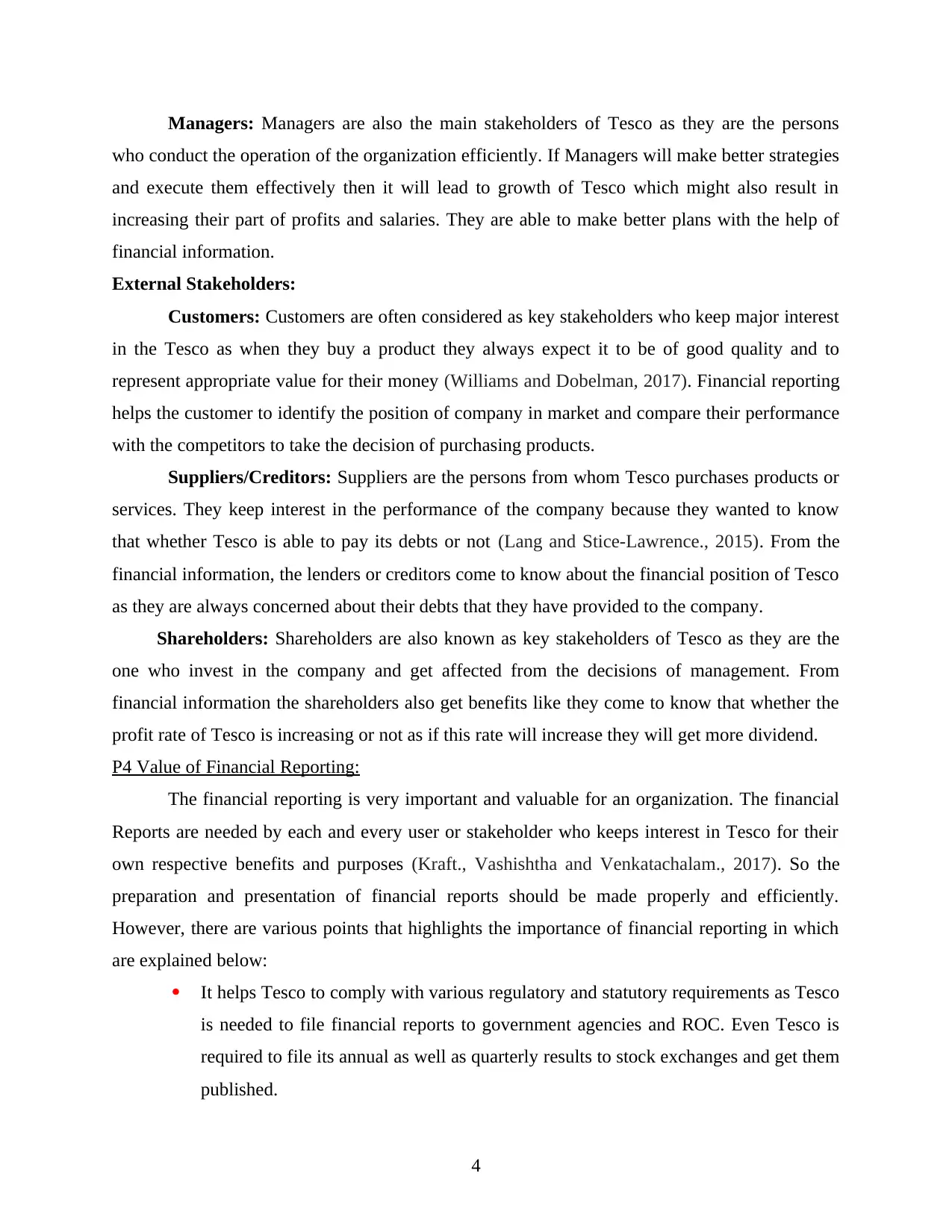
Managers: Managers are also the main stakeholders of Tesco as they are the persons
who conduct the operation of the organization efficiently. If Managers will make better strategies
and execute them effectively then it will lead to growth of Tesco which might also result in
increasing their part of profits and salaries. They are able to make better plans with the help of
financial information.
External Stakeholders:
Customers: Customers are often considered as key stakeholders who keep major interest
in the Tesco as when they buy a product they always expect it to be of good quality and to
represent appropriate value for their money (Williams and Dobelman, 2017). Financial reporting
helps the customer to identify the position of company in market and compare their performance
with the competitors to take the decision of purchasing products.
Suppliers/Creditors: Suppliers are the persons from whom Tesco purchases products or
services. They keep interest in the performance of the company because they wanted to know
that whether Tesco is able to pay its debts or not (Lang and Stice-Lawrence., 2015). From the
financial information, the lenders or creditors come to know about the financial position of Tesco
as they are always concerned about their debts that they have provided to the company.
Shareholders: Shareholders are also known as key stakeholders of Tesco as they are the
one who invest in the company and get affected from the decisions of management. From
financial information the shareholders also get benefits like they come to know that whether the
profit rate of Tesco is increasing or not as if this rate will increase they will get more dividend.
P4 Value of Financial Reporting:
The financial reporting is very important and valuable for an organization. The financial
Reports are needed by each and every user or stakeholder who keeps interest in Tesco for their
own respective benefits and purposes (Kraft., Vashishtha and Venkatachalam., 2017). So the
preparation and presentation of financial reports should be made properly and efficiently.
However, there are various points that highlights the importance of financial reporting in which
are explained below:
It helps Tesco to comply with various regulatory and statutory requirements as Tesco
is needed to file financial reports to government agencies and ROC. Even Tesco is
required to file its annual as well as quarterly results to stock exchanges and get them
published.
4
who conduct the operation of the organization efficiently. If Managers will make better strategies
and execute them effectively then it will lead to growth of Tesco which might also result in
increasing their part of profits and salaries. They are able to make better plans with the help of
financial information.
External Stakeholders:
Customers: Customers are often considered as key stakeholders who keep major interest
in the Tesco as when they buy a product they always expect it to be of good quality and to
represent appropriate value for their money (Williams and Dobelman, 2017). Financial reporting
helps the customer to identify the position of company in market and compare their performance
with the competitors to take the decision of purchasing products.
Suppliers/Creditors: Suppliers are the persons from whom Tesco purchases products or
services. They keep interest in the performance of the company because they wanted to know
that whether Tesco is able to pay its debts or not (Lang and Stice-Lawrence., 2015). From the
financial information, the lenders or creditors come to know about the financial position of Tesco
as they are always concerned about their debts that they have provided to the company.
Shareholders: Shareholders are also known as key stakeholders of Tesco as they are the
one who invest in the company and get affected from the decisions of management. From
financial information the shareholders also get benefits like they come to know that whether the
profit rate of Tesco is increasing or not as if this rate will increase they will get more dividend.
P4 Value of Financial Reporting:
The financial reporting is very important and valuable for an organization. The financial
Reports are needed by each and every user or stakeholder who keeps interest in Tesco for their
own respective benefits and purposes (Kraft., Vashishtha and Venkatachalam., 2017). So the
preparation and presentation of financial reports should be made properly and efficiently.
However, there are various points that highlights the importance of financial reporting in which
are explained below:
It helps Tesco to comply with various regulatory and statutory requirements as Tesco
is needed to file financial reports to government agencies and ROC. Even Tesco is
required to file its annual as well as quarterly results to stock exchanges and get them
published.
4
⊘ This is a preview!⊘
Do you want full access?
Subscribe today to unlock all pages.

Trusted by 1+ million students worldwide
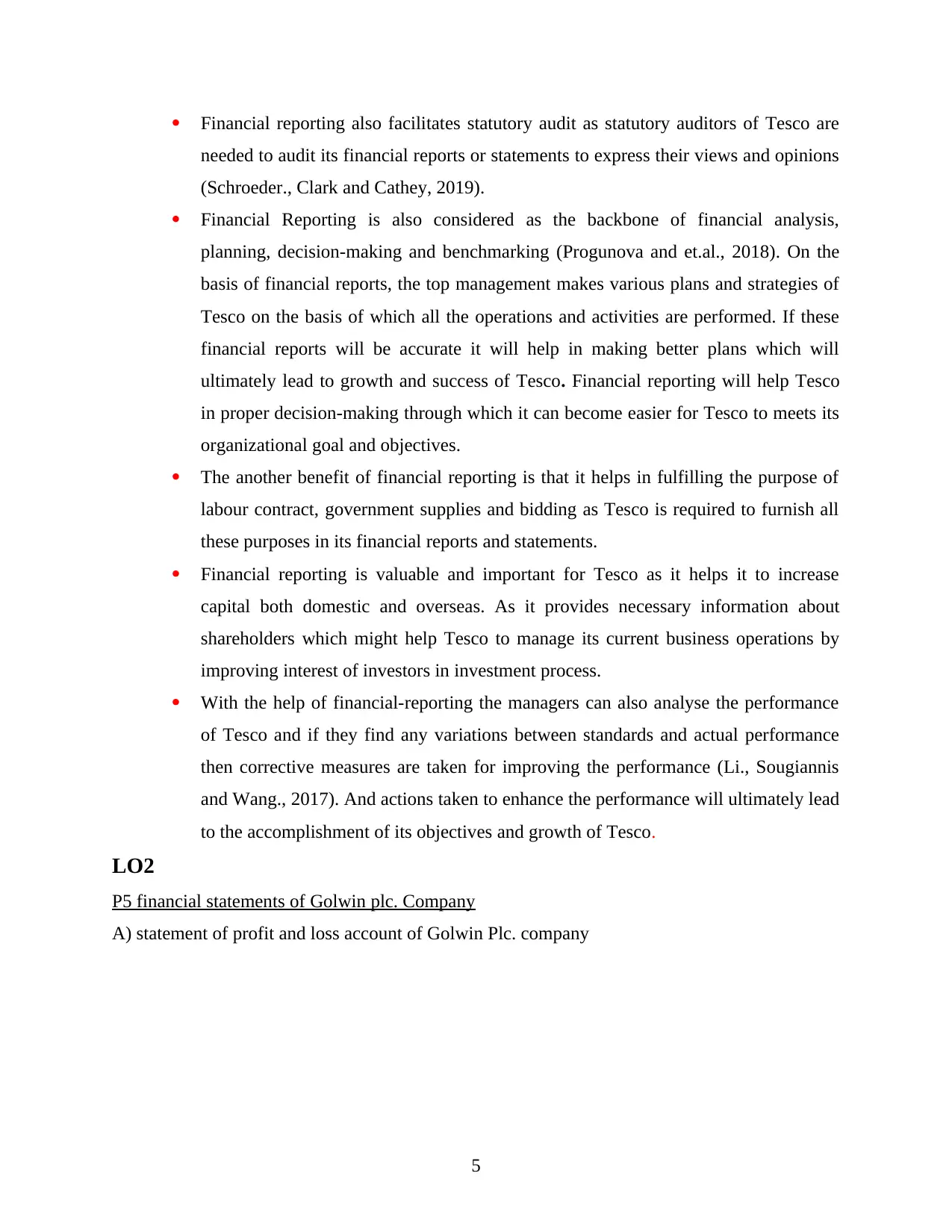
Financial reporting also facilitates statutory audit as statutory auditors of Tesco are
needed to audit its financial reports or statements to express their views and opinions
(Schroeder., Clark and Cathey, 2019).
Financial Reporting is also considered as the backbone of financial analysis,
planning, decision-making and benchmarking (Progunova and et.al., 2018). On the
basis of financial reports, the top management makes various plans and strategies of
Tesco on the basis of which all the operations and activities are performed. If these
financial reports will be accurate it will help in making better plans which will
ultimately lead to growth and success of Tesco. Financial reporting will help Tesco
in proper decision-making through which it can become easier for Tesco to meets its
organizational goal and objectives.
The another benefit of financial reporting is that it helps in fulfilling the purpose of
labour contract, government supplies and bidding as Tesco is required to furnish all
these purposes in its financial reports and statements.
Financial reporting is valuable and important for Tesco as it helps it to increase
capital both domestic and overseas. As it provides necessary information about
shareholders which might help Tesco to manage its current business operations by
improving interest of investors in investment process.
With the help of financial-reporting the managers can also analyse the performance
of Tesco and if they find any variations between standards and actual performance
then corrective measures are taken for improving the performance (Li., Sougiannis
and Wang., 2017). And actions taken to enhance the performance will ultimately lead
to the accomplishment of its objectives and growth of Tesco.
LO2
P5 financial statements of Golwin plc. Company
A) statement of profit and loss account of Golwin Plc. company
5
needed to audit its financial reports or statements to express their views and opinions
(Schroeder., Clark and Cathey, 2019).
Financial Reporting is also considered as the backbone of financial analysis,
planning, decision-making and benchmarking (Progunova and et.al., 2018). On the
basis of financial reports, the top management makes various plans and strategies of
Tesco on the basis of which all the operations and activities are performed. If these
financial reports will be accurate it will help in making better plans which will
ultimately lead to growth and success of Tesco. Financial reporting will help Tesco
in proper decision-making through which it can become easier for Tesco to meets its
organizational goal and objectives.
The another benefit of financial reporting is that it helps in fulfilling the purpose of
labour contract, government supplies and bidding as Tesco is required to furnish all
these purposes in its financial reports and statements.
Financial reporting is valuable and important for Tesco as it helps it to increase
capital both domestic and overseas. As it provides necessary information about
shareholders which might help Tesco to manage its current business operations by
improving interest of investors in investment process.
With the help of financial-reporting the managers can also analyse the performance
of Tesco and if they find any variations between standards and actual performance
then corrective measures are taken for improving the performance (Li., Sougiannis
and Wang., 2017). And actions taken to enhance the performance will ultimately lead
to the accomplishment of its objectives and growth of Tesco.
LO2
P5 financial statements of Golwin plc. Company
A) statement of profit and loss account of Golwin Plc. company
5
Paraphrase This Document
Need a fresh take? Get an instant paraphrase of this document with our AI Paraphraser
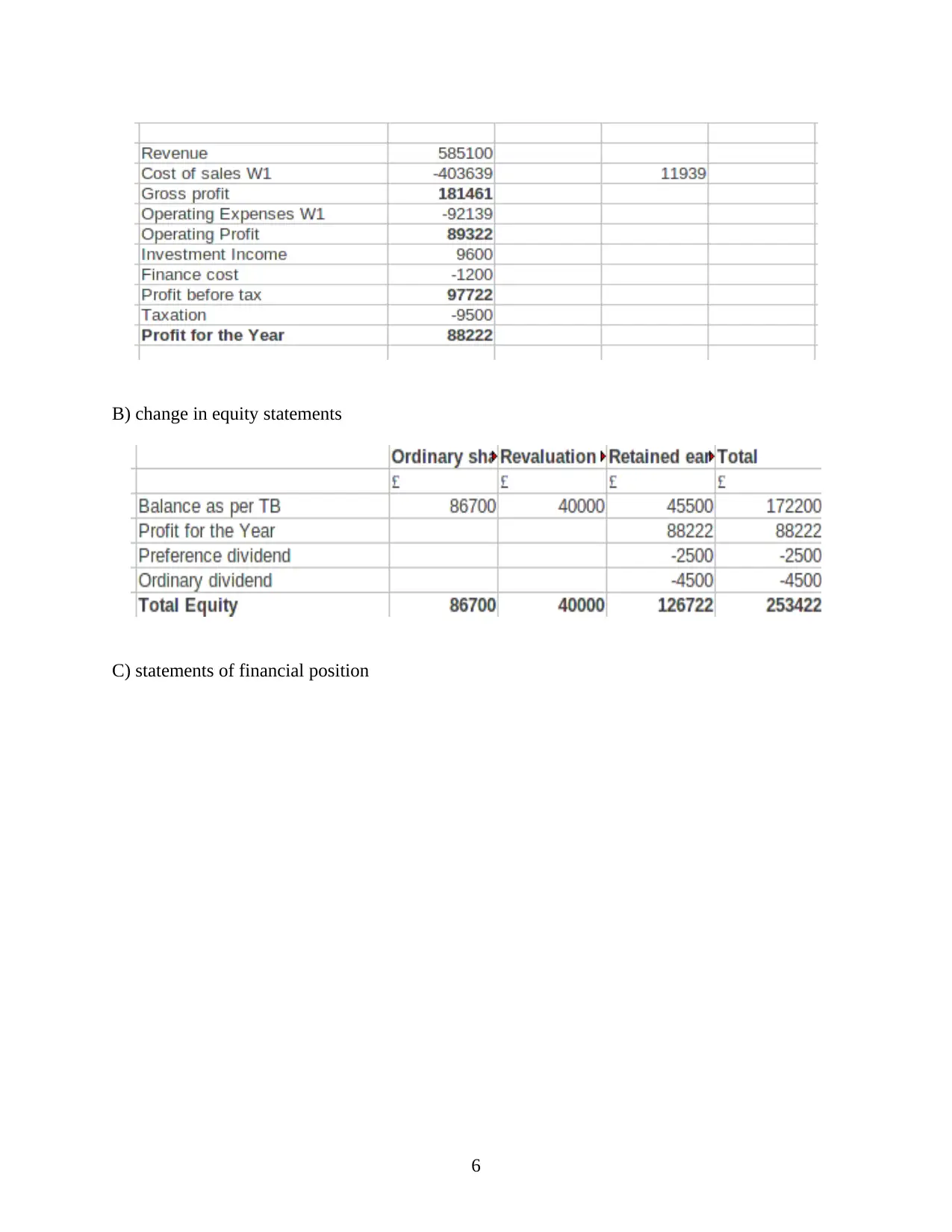
B) change in equity statements
C) statements of financial position
6
C) statements of financial position
6
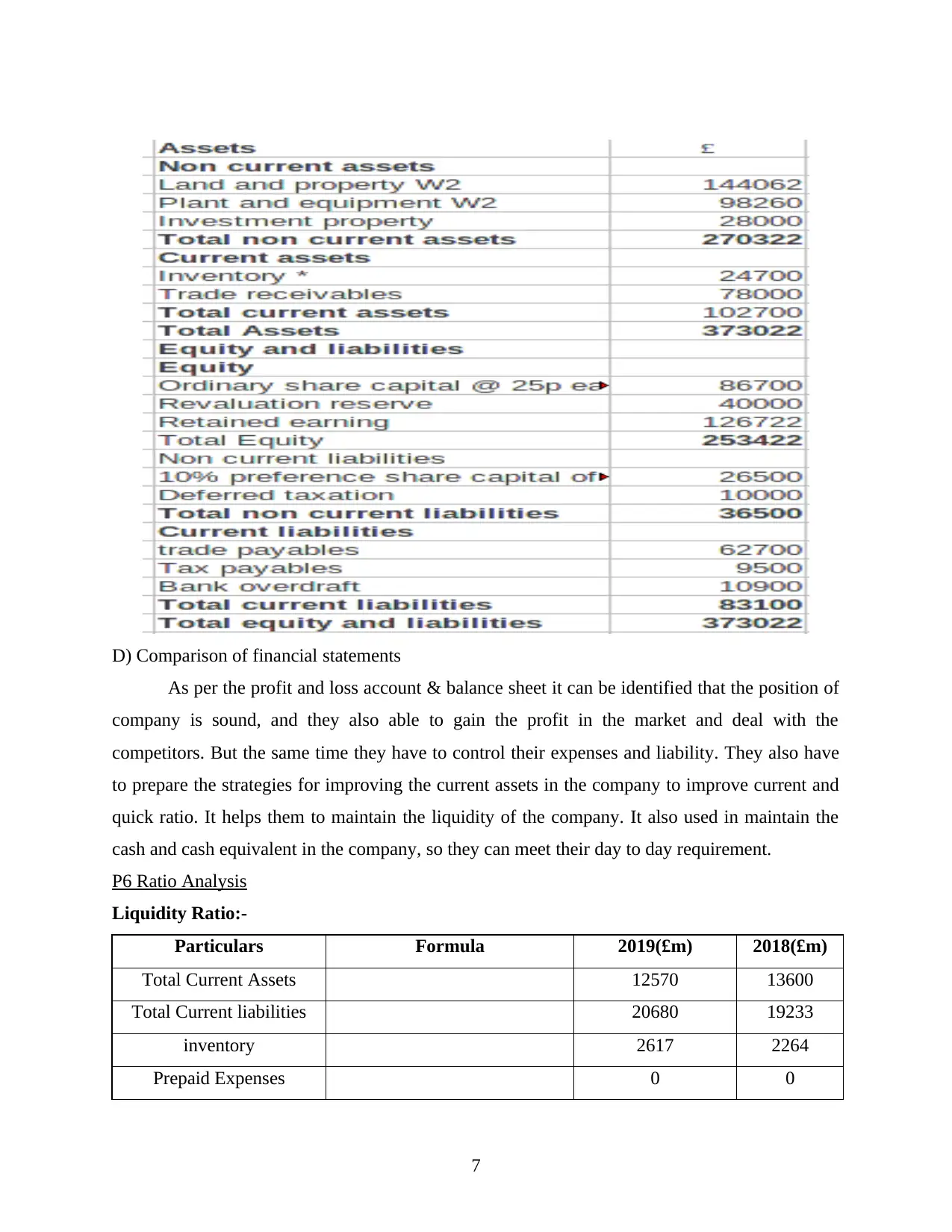
D) Comparison of financial statements
As per the profit and loss account & balance sheet it can be identified that the position of
company is sound, and they also able to gain the profit in the market and deal with the
competitors. But the same time they have to control their expenses and liability. They also have
to prepare the strategies for improving the current assets in the company to improve current and
quick ratio. It helps them to maintain the liquidity of the company. It also used in maintain the
cash and cash equivalent in the company, so they can meet their day to day requirement.
P6 Ratio Analysis
Liquidity Ratio:-
Particulars Formula 2019(£m) 2018(£m)
Total Current Assets 12570 13600
Total Current liabilities 20680 19233
inventory 2617 2264
Prepaid Expenses 0 0
7
As per the profit and loss account & balance sheet it can be identified that the position of
company is sound, and they also able to gain the profit in the market and deal with the
competitors. But the same time they have to control their expenses and liability. They also have
to prepare the strategies for improving the current assets in the company to improve current and
quick ratio. It helps them to maintain the liquidity of the company. It also used in maintain the
cash and cash equivalent in the company, so they can meet their day to day requirement.
P6 Ratio Analysis
Liquidity Ratio:-
Particulars Formula 2019(£m) 2018(£m)
Total Current Assets 12570 13600
Total Current liabilities 20680 19233
inventory 2617 2264
Prepaid Expenses 0 0
7
⊘ This is a preview!⊘
Do you want full access?
Subscribe today to unlock all pages.

Trusted by 1+ million students worldwide

Quick Assets Total current Assets-
(inventory+ Prepaid Expenses)
10916 12907
Current Ratio Total current
Assets / Total
Current Liabilities
0.61 0.71
Quick Ratio Quick Assets / Total
Current Liabilities
0.53 0.67
Interpretation: From the above table it is interpreted that the Current Ratio of Tesco is
0.61 in 2018 and 0.71 in 2019. However, it is showing an increase in current ratio but still it is
far from ideal current ratio. The ideal current ratio is considered as 2:1 which depicts the
organization's ability to remain solvent. Apart from that the quick ratio is 0.53 in 2018 and 0.67
in 2019 which is stating a minor increase but it is also less than ideal quick ratio. Generally, the
ideal quick ratio is taken as 1:1 which depicts the liquidity position of the company. Since the
current and quick is less than 1 which means that the liquidity position of Tesco is not sound and
efficient.
Profitability Ratio:
Particulars Formula 2019(£m) 2018(£m)
Sales 63911 57493
Gross Profit 4144 3352
Net Profit 1674 1300
Gross Profit Ratio(%) Gross Profit
/ Sales
6.48 5.83
Net Profit Ratio(%) Net Profit
/ Sales
2.62 2.26
Interpretation: The above table interprets that the Gross profit ratio of Tesco was 5.83%
in 2018 and 6.48% in 2019 Which is showing a minor increase but still it is not considered as the
ideal GP ratio. The ideal GP ratio depicts the gross profits of company after deducting the cost of
goods sold. Apart from that the Net Profit Ratio was 2.26 in 2018 and 2.62 in 2019 and this is
also stating a minor increase in the profit rates. So the net profit rates of Tesco is not taken as
8
(inventory+ Prepaid Expenses)
10916 12907
Current Ratio Total current
Assets / Total
Current Liabilities
0.61 0.71
Quick Ratio Quick Assets / Total
Current Liabilities
0.53 0.67
Interpretation: From the above table it is interpreted that the Current Ratio of Tesco is
0.61 in 2018 and 0.71 in 2019. However, it is showing an increase in current ratio but still it is
far from ideal current ratio. The ideal current ratio is considered as 2:1 which depicts the
organization's ability to remain solvent. Apart from that the quick ratio is 0.53 in 2018 and 0.67
in 2019 which is stating a minor increase but it is also less than ideal quick ratio. Generally, the
ideal quick ratio is taken as 1:1 which depicts the liquidity position of the company. Since the
current and quick is less than 1 which means that the liquidity position of Tesco is not sound and
efficient.
Profitability Ratio:
Particulars Formula 2019(£m) 2018(£m)
Sales 63911 57493
Gross Profit 4144 3352
Net Profit 1674 1300
Gross Profit Ratio(%) Gross Profit
/ Sales
6.48 5.83
Net Profit Ratio(%) Net Profit
/ Sales
2.62 2.26
Interpretation: The above table interprets that the Gross profit ratio of Tesco was 5.83%
in 2018 and 6.48% in 2019 Which is showing a minor increase but still it is not considered as the
ideal GP ratio. The ideal GP ratio depicts the gross profits of company after deducting the cost of
goods sold. Apart from that the Net Profit Ratio was 2.26 in 2018 and 2.62 in 2019 and this is
also stating a minor increase in the profit rates. So the net profit rates of Tesco is not taken as
8
Paraphrase This Document
Need a fresh take? Get an instant paraphrase of this document with our AI Paraphraser
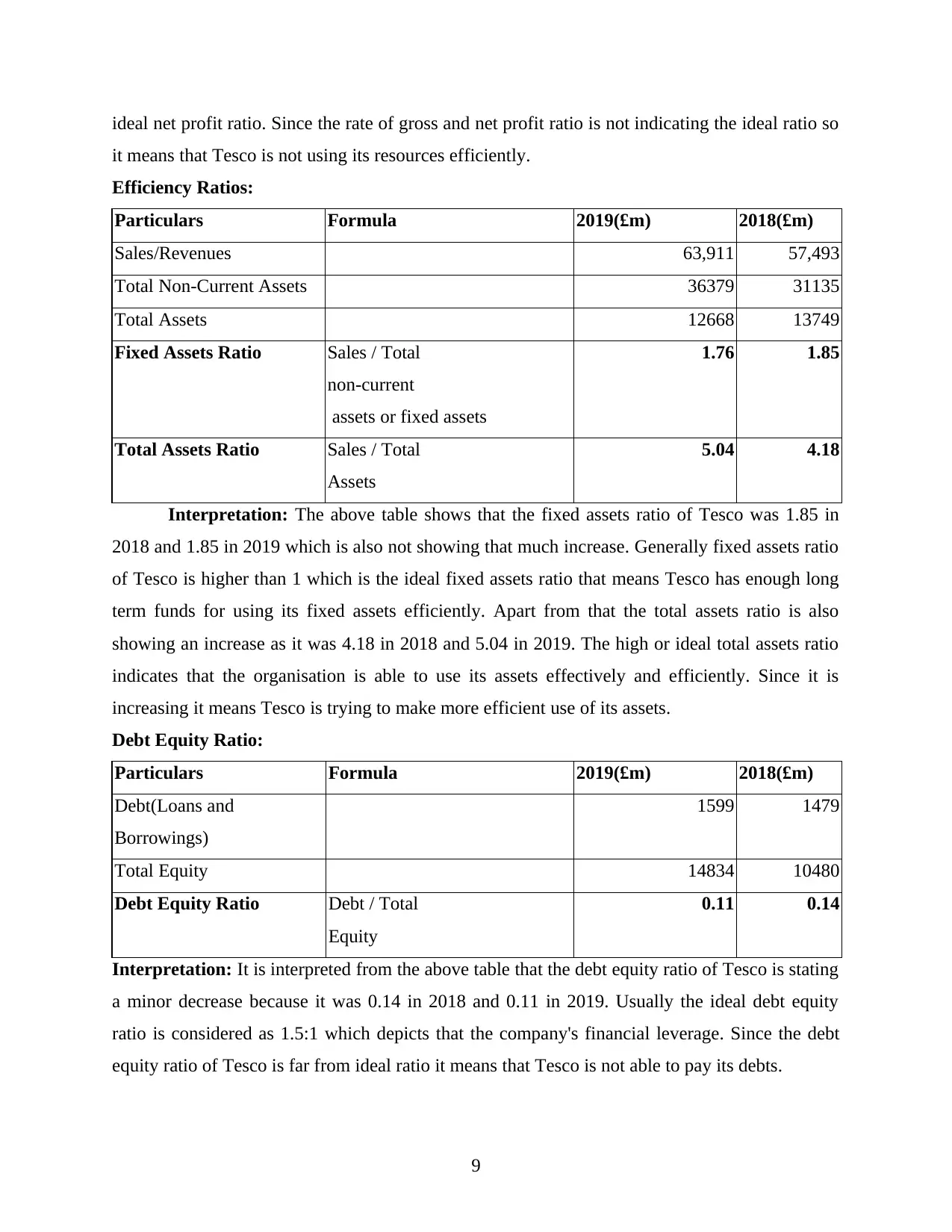
ideal net profit ratio. Since the rate of gross and net profit ratio is not indicating the ideal ratio so
it means that Tesco is not using its resources efficiently.
Efficiency Ratios:
Particulars Formula 2019(£m) 2018(£m)
Sales/Revenues 63,911 57,493
Total Non-Current Assets 36379 31135
Total Assets 12668 13749
Fixed Assets Ratio Sales / Total
non-current
assets or fixed assets
1.76 1.85
Total Assets Ratio Sales / Total
Assets
5.04 4.18
Interpretation: The above table shows that the fixed assets ratio of Tesco was 1.85 in
2018 and 1.85 in 2019 which is also not showing that much increase. Generally fixed assets ratio
of Tesco is higher than 1 which is the ideal fixed assets ratio that means Tesco has enough long
term funds for using its fixed assets efficiently. Apart from that the total assets ratio is also
showing an increase as it was 4.18 in 2018 and 5.04 in 2019. The high or ideal total assets ratio
indicates that the organisation is able to use its assets effectively and efficiently. Since it is
increasing it means Tesco is trying to make more efficient use of its assets.
Debt Equity Ratio:
Particulars Formula 2019(£m) 2018(£m)
Debt(Loans and
Borrowings)
1599 1479
Total Equity 14834 10480
Debt Equity Ratio Debt / Total
Equity
0.11 0.14
Interpretation: It is interpreted from the above table that the debt equity ratio of Tesco is stating
a minor decrease because it was 0.14 in 2018 and 0.11 in 2019. Usually the ideal debt equity
ratio is considered as 1.5:1 which depicts that the company's financial leverage. Since the debt
equity ratio of Tesco is far from ideal ratio it means that Tesco is not able to pay its debts.
9
it means that Tesco is not using its resources efficiently.
Efficiency Ratios:
Particulars Formula 2019(£m) 2018(£m)
Sales/Revenues 63,911 57,493
Total Non-Current Assets 36379 31135
Total Assets 12668 13749
Fixed Assets Ratio Sales / Total
non-current
assets or fixed assets
1.76 1.85
Total Assets Ratio Sales / Total
Assets
5.04 4.18
Interpretation: The above table shows that the fixed assets ratio of Tesco was 1.85 in
2018 and 1.85 in 2019 which is also not showing that much increase. Generally fixed assets ratio
of Tesco is higher than 1 which is the ideal fixed assets ratio that means Tesco has enough long
term funds for using its fixed assets efficiently. Apart from that the total assets ratio is also
showing an increase as it was 4.18 in 2018 and 5.04 in 2019. The high or ideal total assets ratio
indicates that the organisation is able to use its assets effectively and efficiently. Since it is
increasing it means Tesco is trying to make more efficient use of its assets.
Debt Equity Ratio:
Particulars Formula 2019(£m) 2018(£m)
Debt(Loans and
Borrowings)
1599 1479
Total Equity 14834 10480
Debt Equity Ratio Debt / Total
Equity
0.11 0.14
Interpretation: It is interpreted from the above table that the debt equity ratio of Tesco is stating
a minor decrease because it was 0.14 in 2018 and 0.11 in 2019. Usually the ideal debt equity
ratio is considered as 1.5:1 which depicts that the company's financial leverage. Since the debt
equity ratio of Tesco is far from ideal ratio it means that Tesco is not able to pay its debts.
9
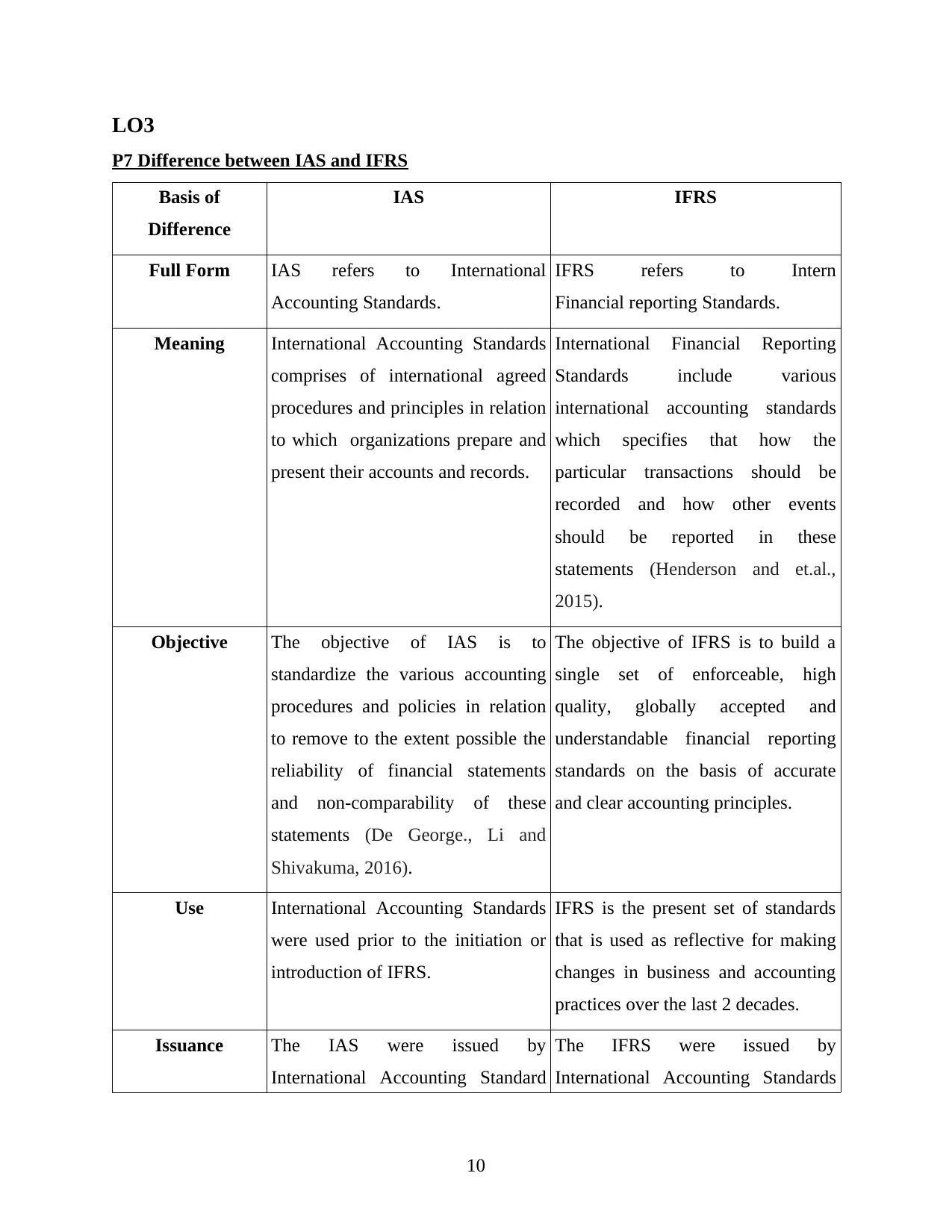
LO3
P7 Difference between IAS and IFRS
Basis of
Difference
IAS IFRS
Full Form IAS refers to International
Accounting Standards.
IFRS refers to Intern
Financial reporting Standards.
Meaning International Accounting Standards
comprises of international agreed
procedures and principles in relation
to which organizations prepare and
present their accounts and records.
International Financial Reporting
Standards include various
international accounting standards
which specifies that how the
particular transactions should be
recorded and how other events
should be reported in these
statements (Henderson and et.al.,
2015).
Objective The objective of IAS is to
standardize the various accounting
procedures and policies in relation
to remove to the extent possible the
reliability of financial statements
and non-comparability of these
statements (De George., Li and
Shivakuma, 2016).
The objective of IFRS is to build a
single set of enforceable, high
quality, globally accepted and
understandable financial reporting
standards on the basis of accurate
and clear accounting principles.
Use International Accounting Standards
were used prior to the initiation or
introduction of IFRS.
IFRS is the present set of standards
that is used as reflective for making
changes in business and accounting
practices over the last 2 decades.
Issuance The IAS were issued by
International Accounting Standard
The IFRS were issued by
International Accounting Standards
10
P7 Difference between IAS and IFRS
Basis of
Difference
IAS IFRS
Full Form IAS refers to International
Accounting Standards.
IFRS refers to Intern
Financial reporting Standards.
Meaning International Accounting Standards
comprises of international agreed
procedures and principles in relation
to which organizations prepare and
present their accounts and records.
International Financial Reporting
Standards include various
international accounting standards
which specifies that how the
particular transactions should be
recorded and how other events
should be reported in these
statements (Henderson and et.al.,
2015).
Objective The objective of IAS is to
standardize the various accounting
procedures and policies in relation
to remove to the extent possible the
reliability of financial statements
and non-comparability of these
statements (De George., Li and
Shivakuma, 2016).
The objective of IFRS is to build a
single set of enforceable, high
quality, globally accepted and
understandable financial reporting
standards on the basis of accurate
and clear accounting principles.
Use International Accounting Standards
were used prior to the initiation or
introduction of IFRS.
IFRS is the present set of standards
that is used as reflective for making
changes in business and accounting
practices over the last 2 decades.
Issuance The IAS were issued by
International Accounting Standard
The IFRS were issued by
International Accounting Standards
10
⊘ This is a preview!⊘
Do you want full access?
Subscribe today to unlock all pages.

Trusted by 1+ million students worldwide
1 out of 16
Related Documents
Your All-in-One AI-Powered Toolkit for Academic Success.
+13062052269
info@desklib.com
Available 24*7 on WhatsApp / Email
![[object Object]](/_next/static/media/star-bottom.7253800d.svg)
Unlock your academic potential
Copyright © 2020–2025 A2Z Services. All Rights Reserved. Developed and managed by ZUCOL.





